Trigger-Based Systems as a Promising Foundation for the Development of Computing Architectures Based on Neuromorphic Materials
Abstract
1. Introduction
2. Methods
3. Results
3.1. Utilization of Trigger-Based Systems for Computation Modulo Mersenne Numbers
3.2. Comparison of the Effective Digit Capacity of an Adder Based on Mersenne Numbers with the Capacity of Existing Adders
3.3. Algorithm for the Carry Operation Across Groups of Digits
4. Discussion
5. Conclusions
Supplementary Materials
Author Contributions
Funding
Institutional Review Board Statement
Informed Consent Statement
Data Availability Statement
Conflicts of Interest
References
- Demir, B.; Akin Gultakti, C.; Koker, Z.; Anantram, M.P.; Oren, E.E. Electronic Properties of DNA Origami Nanostructures Revealed by In Silico Calculations. J. Phys. Chem. B 2024, 128, 4646–4654. [Google Scholar] [CrossRef]
- Katz, E. DNA- and RNA-Based Computing Systems, 1st ed.; Wiley-VCH: Weinheim, Germany, 2021. [Google Scholar]
- Fan, D.; Wang, J.; Wang, E.; Dong, S. Propelling DNA Computing with Materials’ Power: Recent Advancements in Innovative DNA Logic Computing Systems and Smart Bio-Applications. Adv. Sci. 2020, 7, 2001766. [Google Scholar] [CrossRef] [PubMed]
- Krauhausen, I.; Coen, C.; Spolaor, S.; Gkoupidenis, P.; Van De Burgt, Y. Brain-Inspired Organic Electronics: Merging Neuromorphic Computing and Bioelectronics Using Conductive Polymers. Adv. Funct. Mater. 2024, 34, 2307729. [Google Scholar] [CrossRef]
- Friederich, P.; Fediai, A.; Kaiser, S.; Konrad, M.; Jung, N.; Wenzel, W. Toward Design of Novel Materials for Organic Electronics. Adv. Mater. 2019, 31, 1808256. [Google Scholar] [CrossRef] [PubMed]
- Casalini, S.; Bortolotti, C.A.; Leonardi, F.; Biscarini, F. Self-Assembled Monolayers in Organic Electronics. Chem. Soc. Rev. 2017, 46, 40–71. [Google Scholar] [CrossRef]
- Kukhta, N.A.; Marks, A.; Luscombe, C.K. Molecular Design Strategies Toward Improvement of Charge Injection and Ionic Conduction in Organic Mixed Ionic–Electronic Conductors for Organic Electrochemical Transistors. Chem. Rev. 2021, 122, 4325–4355. [Google Scholar] [CrossRef]
- Rivnay, J.; Inal, S.; Salleo, A.; Owens, R.M.; Berggren, M.; Malliaras, G.G. Organic Electrochemical Transistors. Nat. Rev. Mater. 2018, 3, 17086. [Google Scholar] [CrossRef]
- Huang, W.; Chen, J.; Yao, Y.; Zheng, D.; Ji, X.; Feng, L.W.; Facchetti, A. Vertical Organic Electrochemical Transistors for Complementary Circuits. Nature 2023, 613, 496–502. [Google Scholar] [CrossRef]
- Bryce, M.R. A Review of Functional Linear Carbon Chains and Their Applications as Molecular Wires in Electronics and Optoelectronics. J. Mater. Chem. C 2021, 9, 10524–10546. [Google Scholar] [CrossRef]
- Yu, P.; Zhen, Y.; Dong, H.; Hu, W. Crystal Engineering of Organic Optoelectronic Materials. Chem 2019, 5, 2814–2853. [Google Scholar] [CrossRef]
- Ullbrich, S.; Benduhn, J.; Jia, X.; Nikolis, V.C.; Tvingstedt, K.; Piersimoni, F.; Vandewal, K. Emissive and Charge-Generating Interfaces for Optoelectronics. Nat. Mater. 2019, 18, 459–464. [Google Scholar] [CrossRef]
- Shalf, J. The Future of Computing Beyond Moore’s Law. Philos. Trans. R. Soc. A 2020, 378, 2166. [Google Scholar] [CrossRef]
- Leiserson, C.E.; Thompson, N.C.; Emer, J.S.; Kuszmaul, B.C.; Lampson, B.W.; Sanchez, D.; Schardl, T.B. There’s Plenty of Room at the Top: What Will Drive Computer Performance After Moore’s Law? Science 2020, 368, eaam9744. [Google Scholar] [CrossRef] [PubMed]
- Suleimenov, I.; Gabrielyan, O.; Kopishev, E.; Kadyrzhan, A.; Bakirov, A.; Vitulyova, Y. Advanced Applications of Polymer Hydrogels in Electronics and Signal Processing. Gels 2024, 10, 715. [Google Scholar] [CrossRef] [PubMed]
- Niu, X.; Tian, B.; Zhu, Q.; Dkhil, B.; Duan, C. Ferroelectric Polymers for Neuromorphic Computing. Appl. Phys. Rev. 2022, 9, 021309. [Google Scholar] [CrossRef]
- Zhang, B.; Chen, W.; Zeng, J.; Fan, F.; Gu, J.; Chen, X.; Yan, L.; Xie, G.; Liu, S.; Yan, Q.; et al. 90% Yield Production of Polymer Nano-Memristor for In-Memory Computing. Nat. Commun. 2021, 12, 1984. [Google Scholar] [CrossRef]
- Gumyusenge, A.; Melianas, A.; Keene, S.T.; Salleo, A. Materials Strategies for Organic Neuromorphic Devices. Annu. Rev. Mater. Res. 2021, 51, 47–71. [Google Scholar] [CrossRef]
- Melianas, A.; Quill, T.J.; LeCroy, G.; Tuchman, Y.; Loo, H.V.; Keene, S.T.; Giovannitti, A.; Lee, H.R.; Maria, I.P.; McCulloch, I.; et al. Temperature-Resilient Solid-State Organic Artificial Synapses for Neuromorphic Computing. Sci. Adv. 2020, 6, eabb2958. [Google Scholar] [CrossRef]
- Park, M.H.; Kim, Y.; Choi, M.J.; Kim, Y.B.; Yun, J.M.; Jeong, J.H.; Kang, S.J. Enhanced In-Sensor Computing with Spike Number-Dependent Plasticity in an InGaSnO Neuromorphic Device. ACS Nano 2025, 19, 13107–13117. [Google Scholar] [CrossRef]
- Hoch, F.L.; Wang, Q.; Lim, K.G.; Loke, D.K. Multifunctional Organic Materials, Devices, and Mechanisms for Neuroscience, Neuromorphic Computing, and Bioelectronics. Nano-Micro Lett. 2025, 17, 251. [Google Scholar] [CrossRef]
- Kim, K.N.; Sung, M.J.; Park, H.L.; Lee, T.W. Organic Synaptic Transistors for Bio-Hybrid Neuromorphic Electronics. Adv. Electron. Mater. 2022, 8, 2100935. [Google Scholar] [CrossRef]
- Tuchman, Y.; Mangoma, T.N.; Gkoupidenis, P.; Van De Burgt, Y.; John, R.A.; Mathews, N.; Salleo, A. Organic Neuromorphic Devices: Past, Present, and Future Challenges. MRS Bull. 2020, 45, 619–630. [Google Scholar] [CrossRef]
- Wu, X.; Wang, S.; Huang, W.; Dong, Y.; Wang, Z.; Huang, W. Wearable In-Sensor Reservoir Computing Using Optoelectronic Polymers with Through-Space Charge-Transport Characteristics for Multi-Task Learning. Nat. Commun. 2023, 14, 468. [Google Scholar] [CrossRef] [PubMed]
- Krauhausen, I.; Koutsouras, D.A.; Melianas, A.; Keene, S.T.; Lieberth, K.; Ledanseur, H.; Sheelamanthula, R.; Giovannitti, A.; Torricelli, F.; Mcculloch, I.; et al. Organic Neuromorphic Electronics for Sensorimotor Integration and Learning in Robotics. Sci. Adv. 2021, 7, eabl5068. [Google Scholar] [CrossRef] [PubMed]
- Wang, W.; Jiang, Y.; Zhong, D.; Zhang, Z.; Choudhury, S.; Lai, J.-C.; Gong, H.; Niu, S.; Yan, X.; Zheng, Y.; et al. Neuromorphic Sensorimotor Loop Embodied by Monolithically Integrated, Low-Voltage, Soft e-Skin. Science 2023, 380, 735–742. [Google Scholar] [CrossRef]
- Choi, Y.; Jeong, S.; Jeong, H.; Han, S.; Ko, J.; Yu, S.E.; Bae, S.H. Advanced AI Computing Enabled by 2D Material-Based Neuromorphic Devices. npj Unconv. Comput. 2025, 2, 8. [Google Scholar] [CrossRef]
- Gandolfi, D.; Mapelli, J.; Puglisi, F.M. Brain-Inspired Computing: From Neuroscience to Neuromorphic Electronics for New Forms of Artificial Intelligence. Front. Neurosci. 2025, 19, 1565811. [Google Scholar] [CrossRef]
- Li, Y.; Ding, G.; Zhai, Y.; Lv, Z.; Yan, Y.; Xue, S.; Han, S.T. MXene-Based Flexible Memory and Neuromorphic Devices. Small 2025, 2410914. [Google Scholar] [CrossRef]
- Ibrahim, R.; Shafiq, M.O. Explainable Convolutional Neural Networks: A Taxonomy, Review, and Future Directions. ACM Comput. Surv. 2023, 55, 1–37. [Google Scholar] [CrossRef]
- Damilola, S. A Review of Unsupervised Artificial Neural Networks with Applications. Int. J. Comput. Appl. 2019, 181, 22–26. [Google Scholar] [CrossRef]
- Dike, H.U.; Zhou, Y.; Deveerasetty, K.K.; Wu, Q. Unsupervised Learning Based on Artificial Neural Network: A Review. In Proceedings of the 2018 IEEE International Conference on Cyborg and Bionic Systems (CBS), Shenzhen, China, 25–27 October 2018; IEEE: Piscataway, NJ, USA, 2018; pp. 322–327. [Google Scholar] [CrossRef]
- Adadi, A.; Berrada, M. Peeking Inside the Black-Box: A Survey on Explainable Artificial Intelligence (XAI). IEEE Access 2018, 6, 52138–52160. [Google Scholar] [CrossRef]
- Carloni, G.; Berti, A.; Colantonio, S. The Role of Causality in Explainable Artificial Intelligence. Wiley Interdiscip. Rev. Data Min. Knowl. Discov. 2025, 15, e70015. [Google Scholar] [CrossRef]
- Mersha, M.; Lam, K.; Wood, J.; AlShami, A.K.; Kalita, J. Explainable Artificial Intelligence: A Survey of Needs, Techniques, Applications, and Future Direction. Neurocomputing 2024, 599, 128111. [Google Scholar] [CrossRef]
- Perera, J.; Balasubramaniam, S.; Somathilaka, S.; Wen, Q.; Li, X.; Kasthurirathna, D.; Nelson, T. Wet-Neuromorphic Computing: A New Paradigm for Biological Artificial Intelligence. IEEE Intell. Syst. 2025, 40, 39–48. [Google Scholar] [CrossRef]
- Shi, X.; Ma, J.-G.; Yeo, K.S.; Do, M.A.; Li, E. Equivalent Circuit Model of On-Wafer CMOS Interconnects for RFICs. IEEE Trans. VLSI Syst. 2005, 13, 1060–1071. [Google Scholar] [CrossRef]
- Gielen, G.; Dehaene, W. Analog and Digital Circuit Design in 65 nm CMOS: End of the Road? In Proceedings of the Design, Automation and Test in Europe, Munich, Germany, 7–11 March 2005; Volume 1, pp. 37–42. [Google Scholar] [CrossRef]
- Zhang, L.; Dai, Y.; Li, C.; Dang, Y.; Zheng, R.; Wang, Z.; Wang, Y.; Cui, Y.; Arandiyan, H.; Shao, Z.; et al. Recent Advances in Electrochemical Impedance Spectroscopy for Solid-State Batteries. Energy Storage Mater. 2024, 69, 103378. [Google Scholar] [CrossRef]
- Meddings, N.; Heinrich, M.; Overney, F.; Lee, J.-S.; Ruiz, V.; Napolitano, E.; Seitz, S.; Hinds, G.; Raccichini, R.; Gaberšček, M.; et al. Application of Electrochemical Impedance Spectroscopy to Commercial Li-Ion Cells: A Review. J. Power Sources 2020, 480, 227742. [Google Scholar] [CrossRef]
- Hille, B. Ion Channels of Excitable Membranes, 3rd ed.; Sinauer Associates: Sunderland, MA, USA, 2001. [Google Scholar]
- Koch, C. Biophysics of Computation: Information Processing in Single Neurons; Oxford Academic: New York, NY, USA, 1998. [Google Scholar] [CrossRef]
- Binley, A.; Kemna, A. DC Resistivity and Induced Polarization Methods. In Hydrogeophysics; Rubin, Y., Hubbard, S.S., Eds.; Springer: Dordrecht, The Netherlands, 2005; pp. 129–156. [Google Scholar] [CrossRef]
- Revil, A.; Florsch, N. Determination of Permeability from Spectral Induced Polarization in Granular Media. Geophys. J. Int. 2010, 181, 1480–1498. [Google Scholar] [CrossRef]
- Li, Y.; Su, K.; Chen, H.; Zou, X.; Wang, C.; Man, H.; Liu, K.; Xi, X.; Li, T. Research Progress of Neural Synapses Based on Memristors. Electronics 2023, 12, 3298. [Google Scholar] [CrossRef]
- Ali, M.; Lee, D.; Ahmad, I.; Kim, H.-D. Recent Progress in Memristor-Based Gas Sensors: Device Modeling, Mechanisms, Performance, and Prospects. Sens. Actuators Rep. 2025, 9, 100269. [Google Scholar] [CrossRef]
- Zeumault, A.; Alam, S.; Wood, Z.; Weiss, R.J.; Aziz, A.; Rose, G.S. TCAD Modeling of Resistive-Switching of HfO2 Memristors: Efficient Device-Circuit Co-Design for Neuromorphic Systems. Front. Nanotechnol. 2021, 3, 734121. [Google Scholar] [CrossRef]
- Zhang, W.; Mazzarello, R.; Wuttig, M.; Ma, E. Designing Crystallization in Phase-Change Materials for Universal Memory and Neuro-Inspired Computing. Nat. Rev. Mater. 2019, 4, 150–168. [Google Scholar] [CrossRef]
- AlZaabi, M.; Halawani, Y.; Mohammad, B. In-Memory Computing Using Phase Change Memory. In In-Memory Computing Hardware Accelerators for Data-Intensive Applications; Mohammad, B., Halawani, Y., Eds.; Springer: Cham, Switzerland, 2024. [Google Scholar] [CrossRef]
- Driscoll, T.; Kim, H.-T.; Chae, B.-G.; Di Ventra, M.; Basov, D.N. Phase-Transition Driven Memristive System. Appl. Phys. Lett. 2009, 95, 043503. [Google Scholar] [CrossRef]
- Berdan, R.; Vasilaki, E.; Khiat, A.; Indiveri, G.; Serb, A.; Prodromakis, T. Emulating Short-Term Synaptic Dynamics with Memristive Devices. Sci. Rep. 2016, 6, 18639. [Google Scholar] [CrossRef]
- Wang, Z.; Wu, H.; Burr, G.W.; Hwang, C.S.; Wang, K.L.; Xia, Q.; Yang, J.J. Resistive Switching Materials for Information Processing. Nat. Rev. Mater. 2020, 5, 173–195. [Google Scholar] [CrossRef]
- Yarragolla, S.; Hemke, T.; Jalled, F.; Gergs, T.; Trieschmann, J.; Arul, T.; Mussenbrock, T. Identifying and Understanding the Nonlinear Behavior of Memristive Devices. Sci. Rep. 2024, 14, 31633. [Google Scholar] [CrossRef]
- Zhou, Y.; Ramanathan, S. Mott Memory and Neuromorphic Devices. Proc. IEEE 2015, 103, 1289–1310. [Google Scholar] [CrossRef]
- Ryndin, E.; Andreeva, N.; Luchinin, V. Compact Model for Bipolar and Multilevel Resistive Switching in Metal-Oxide Memristors. Micromachines 2022, 13, 98. [Google Scholar] [CrossRef]
- Oke, A.A.; Nathaniel, B.A.; Bukola, B.F.; Ayopo, O.A. Residue Number System Based Applications: A Literature Review. Ann. Comput. Sci. Ser. 2021, 19, 1. [Google Scholar]
- Chang, C.H.; Molahosseini, A.S.; Zarandi, A.A.E.; Tay, T.F. Residue Number Systems: A New Paradigm to Datapath Optimization for Low-Power and High-Performance Digital Signal Processing Applications. IEEE Circuits Syst. Mag. 2015, 15, 26–44. [Google Scholar] [CrossRef]
- Younes, D.; Steffan, P. Efficient Image Processing Application Using Residue Number System. In Proceedings of the 20th International Conference Mixed Design of Integrated Circuits and Systems-MIXDES 2013, Gdynia, Poland, 20–22 June 2013; IEEE: Piscataway, NJ, USA, 2013; pp. 468–472. [Google Scholar]
- Beuchat, J.-L. Some Modular Adders and Multipliers for Field Programmable Gate Arrays. In Proceedings of the International Parallel and Distributed Processing Symposium, Nice, France, 22–26 April 2003; IEEE: Piscataway, NJ, USA, 2003; pp. 1–8. [Google Scholar] [CrossRef]
- Kuo, C.-T.; Wu, Y.-C. FPGA Implementation of a Novel Multifunction Modulo (2n ± 1) Multiplier Using Radix-4 Booth Encoding Scheme. Appl. Sci. 2023, 13, 10407. [Google Scholar] [CrossRef]
- Abd-Elkader, A.A.H.; Rashdan, M.; Hasaneen, E.A.M.; Hamed, H.F.A. Efficient Implementation of Montgomery Modular Multiplier on FPGA. Comput. Electr. Eng. 2022, 97, 107585. [Google Scholar] [CrossRef]
- Patel, B.K.; Kanungo, J. Efficient Tree Multiplier Design by Using Modulo 2n + 1 Adder. In Proceedings of the 2021 Emerging Trends in Industry 4.0 (ETI 4.0), Raigarh, India, 19–21 May 2021; pp. 1–6. [Google Scholar] [CrossRef]
- Irkhin, V.P.; Obukhov, A.N.; Gul’bin, S.S. Device for Modulo Addition and Subtraction of Numbers. RU Patent 2 145 112 C1, 27 January 2000. [Google Scholar]
- Ebihara, H.; Kiyoto. Circuit for Modulo Multiplication and Exponentiation Arithmetic. EP Patent EP0801345B1, 10 October 2002. [Google Scholar]
- Suprun, V.P. Modulo Four Adder. EA Patent EA030205B1, 31 July 2018. [Google Scholar]
- Petrenko, V.I.; Stepanian, N.E.; Nelidin, I.R. Multi-Digit Parallel Adder Modulo with Serial Transfer. RU Patent RU2724597C1, 25 June 2020. [Google Scholar]
- Suleimenov, I.; Kadyrzhan, A.; Matrassulova, D.; Vitulyova, Y. Peculiarities of Applying Partial Convolutions to the Computation of Reduced Numerical Convolutions. Appl. Sci. 2024, 14, 6388. [Google Scholar] [CrossRef]
- Kadyrzhan, A.; Kadyrzhan, K.; Bakirov, A.; Suleimenov, I. Prospects for the Use of Quasi-Mersen Numbers in the Design of Parallel-Serial Processors. Appl. Sci. 2025, 15, 741. [Google Scholar] [CrossRef]
- Suleimenov, I.E.; Bakirov, A.S.; Matrassulova, D.K. A Technique for Analyzing Neural Networks in Terms of Ternary Logic. J. Theor. Appl. Inf. Technol. 2021, 99, 2537–2553. [Google Scholar]
- Barotov, D.N.; Barotov, R.N. Polylinear Transformation Method for Solving Systems of Logical Equations. Mathematics 2022, 10, 918. [Google Scholar] [CrossRef]
- Barotov, D.N.; Barotov, R.N.; Soloviev, V.; Feklin, V.; Muzafarov, D.; Ergashboev, T.; Egamov, K. Development of Suitable Inequalities and Their Application to Systems of Logical Equations. Mathematics 2022, 10, 1851. [Google Scholar] [CrossRef]
- Suleimenov, I.E.; Vitulyova, Y.S.; Kabdushev, S.B.; Bakirov, A.S. Improving the Efficiency of Using Multivalued Logic Tools. Sci. Rep. 2023, 13, 1108. [Google Scholar] [CrossRef]
- Suleimenov, I.E.; Gabrielyan, O.A.; Bakirov, A.S. Initial Study of General Theory of Complex Systems: Physical Basis and Philosophical Understanding. Bull. Electr. Eng. Inform. 2025, 14, 774–789. [Google Scholar] [CrossRef]
- Hopfield, J.J. Neurons with Graded Response Have Collective Computational Properties Like Those of Two-State Neurons. Proc. Natl. Acad. Sci. USA 1984, 81, 3088–3092. [Google Scholar] [CrossRef]
- Suleimenov, I.E.; Guven, O.; Mun, G.A.; Uzun, C.; Gabrielyan, O.A.; Kabdushev, S.B.; Agibaeva, L.; Nurtazin, A. Hysteresis Effects During the Phase Transition in Solutions of Temperature Sensitive Polymers. Eurasian Chem. Tech. J. 2017, 19, 41. [Google Scholar] [CrossRef]
- Suleimenov, I.E.; Vitulyova, Y.S.; Shaltykova, D.B.; Matrassulova, D.K.; Bakirov, A.S. Pattern Recognition Methods as a Base of Development of New Instruments for Investigations in Physical Chemistry. In Proceedings of the 2022 European Symposium on Software Engineering, Rome, Italy, 27–29 October 2022; pp. 127–132. [Google Scholar]
- Mun, G.A.; Baipakbaeva, S.T.; Kadyrzhan, K.N.; Kabdushev, S.B.; Vitulyova, E.S.; Konshin, S.V.; Suleimenov, I.E. Adder by Module 22 − 1. U.S. Patent 36236, 26 May 2023. [Google Scholar]
- Kornstein, H. 8086—Its Development and Capability. Microprocessors 1978, 2, 166–169. [Google Scholar] [CrossRef]
- Suleimenov, I.; Vitulyova, Y.; Bakirov, A. Hybrid Number Systems: Application for Calculations in Galois Fields. In Proceedings of the 2022 3rd Asia Conference on Computers and Communications (ACCC), Shanghai, China, 16–18 December 2022; IEEE: Piscataway, NJ, USA, 2022; pp. 126–130. [Google Scholar]
- Vitulyova, Y.S.; Bakirov, A.S.; Shaltykova, D.B.; Suleimenov, I.E. Prerequisites for the Analysis of the Neural Networks Functioning in Terms of Projective Geometry. In Proceedings of the 2020 4th International Conference on Information Processing and Control Engineering University of California, Berkeley, CA, USA, 27–29 June 2020; Volume 946, p. 012001. [Google Scholar]
- Radecki, M.; Spěváček, J.; Zhigunov, A.; Sedláková, Z.; Hanyková, L. Temperature-Induced Phase Transition in Hydrogels of Interpenetrating Networks of Poly(N-isopropylacrylamide) and Polyacrylamide. Eur. Polym. J. 2015, 68, 68–79. [Google Scholar] [CrossRef]
- Yang, X.; Ahmad, K.; Yang, T.; Fan, Y.; Zhao, F.; Jiang, S.; Hou, H. Collagen-Based Hydrogel Sol-Gel Phase Transition Mechanism and Their Applications. Adv. Colloid Interface Sci. 2025, 340, 103456. [Google Scholar] [CrossRef]
- Liu, X.; Li, B.; Wang, W.; Zhang, Y.; Li, H.; Li, Z. Multistimuli-Responsive Hydrogels with Both Anisotropic Mechanical Performance and Anisotropic Luminescent Behavior. Chem. Eng. J. 2022, 449, 137718. [Google Scholar] [CrossRef]
- Ruiz, A.L.; Ramirez, A.; McEnnis, K. Single and Multiple Stimuli-Responsive Polymer Particles for Controlled Drug Delivery. Pharmaceutics 2022, 14, 421. [Google Scholar] [CrossRef]
- Wang, Z.; Ye, Q.; Yu, S.; Akhavan, B. Poly (Ethylene Glycol)-Based Hydrogels for Drug Delivery in Cancer Therapy: A Comprehensive Review. Adv. Healthc. Mater. 2023, 12, 2300105. [Google Scholar] [CrossRef]
- Rust, T.; Jung, D.; Langer, K.; Kuckling, D. Stimuli-Accelerated Polymeric Drug Delivery Systems. Polym. Int. 2023, 72, 5–19. [Google Scholar] [CrossRef]
- Suleimenov, I.; Egemberdieva, Z.; Bakirov, A.; Baipakbayeva, S.; Kopishev, E.; Mun, G. Efficiency Problem of Renewable Energetics Systems in the Context of “Smart House” Concept. E3S Web Conf. 2020, 164, 13002. [Google Scholar] [CrossRef]
- Suleimenov, I.; Kadyrzhan, K.; Kabdushev, S.; Bakirov, A.; Kopishev, E. New Equipment for Aromatherapy and Related Mobile App: A Tool to Support Small Peasant Farms in Kazakhstan in Crisis. In Robotics, Machinery and Engineering Technology for Precision Agriculture; Springer: Singapore, 2021; pp. 347–355. [Google Scholar]
- Yar, H.; Imran, A.S.; Khan, Z.A.; Sajjad, M.; Kastrati, Z. Towards Smart Home Automation Using IoT-Enabled Edge-Computing Paradigm. Sensors 2021, 21, 4932. [Google Scholar] [CrossRef]
- Agee, P.; Gao, X.; Paige, F.; McCoy, A.; Kleiner, B. A Human-Centred Approach to Smart Housing. Build. Res. Inf. 2021, 49, 84–99. [Google Scholar] [CrossRef]
- Taiwo, O.; Ezugwu, A.E.; Oyelade, O.N.; Almutairi, M.S. Enhanced Intelligent Smart Home Control and Security System Based on Deep Learning Model. Wirel. Commun. Mob. Comput. 2022, 2022, 9307961. [Google Scholar] [CrossRef]
- Ho, J.C.; Lin, Y.C.; Chen, C.K.; Hsu, L.C.; Chen, W.C. Hydrogel-Based Sustainable and Stretchable Field-Effect Transistors. Org. Electron. 2022, 100, 106358. [Google Scholar] [CrossRef]
- Beck, A.; Obst, F.; Gruner, D.; Voigt, A.; Mehner, P.J.; Gruenzner, S.; Richter, A. Fundamentals of Hydrogel-Based Valves and Chemofluidic Transistors for Lab-on-a-Chip Technology: A Tutorial Review. Adv. Mater. Technol. 2023, 8, 2200417. [Google Scholar] [CrossRef]
- Zhang, Y.; Jeong, C.K.; Wang, J.; Chen, X.; Choi, K.H.; Chen, L.Q.; Wang, Q. Hydrogel Ionic Diodes Toward Harvesting Ultralow-Frequency Mechanical Energy. Adv. Mater. 2021, 33, 2103056. [Google Scholar] [CrossRef]
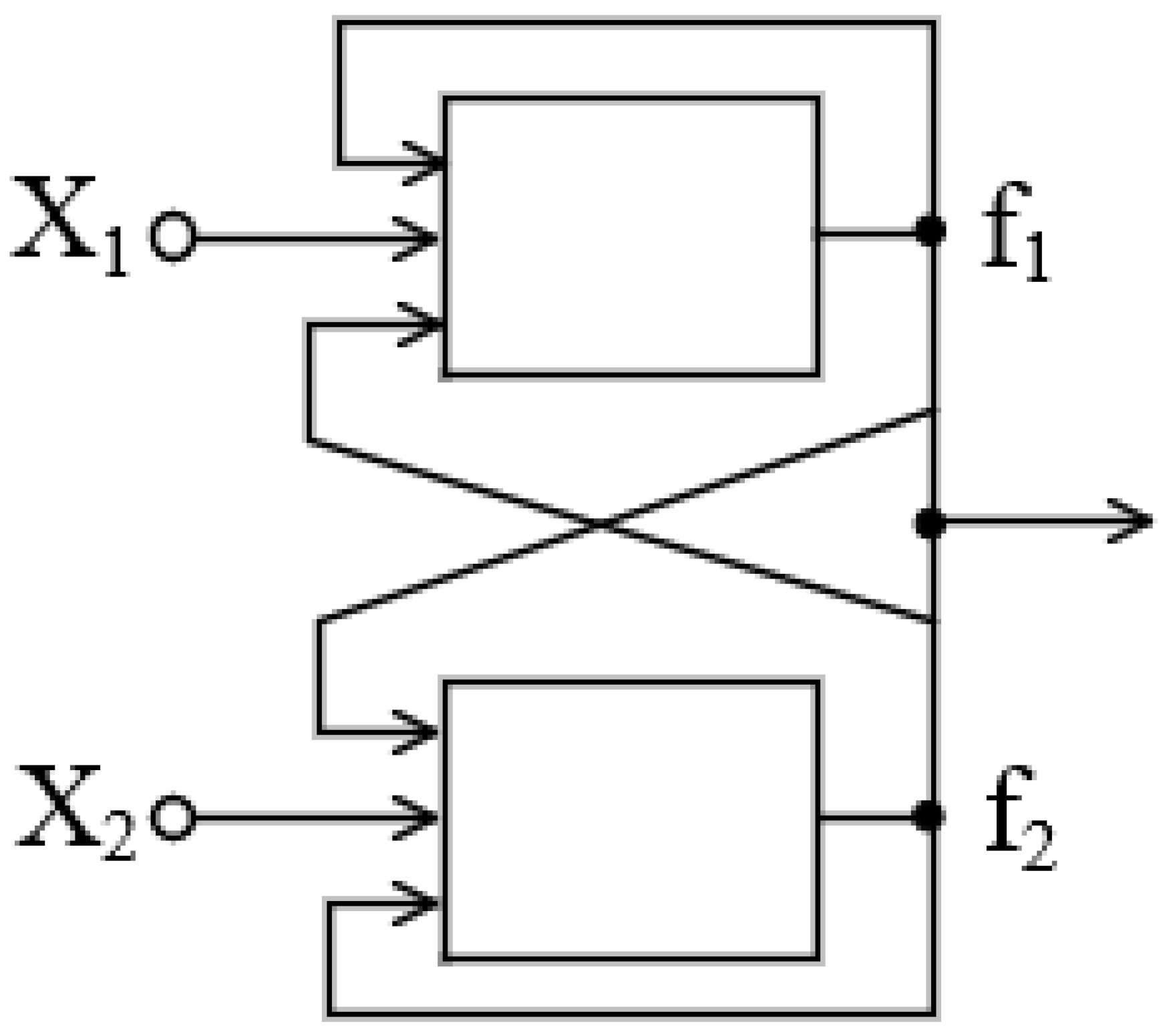

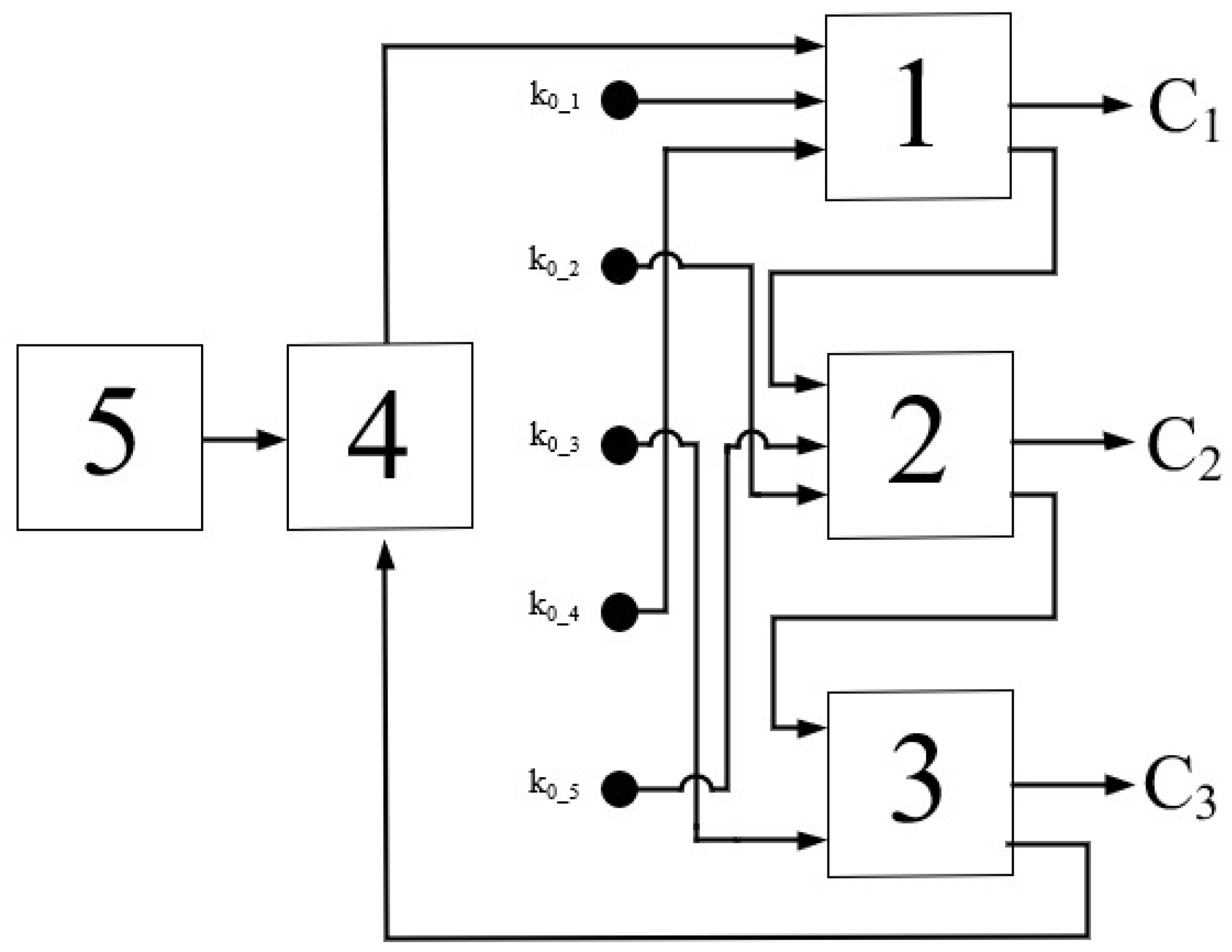
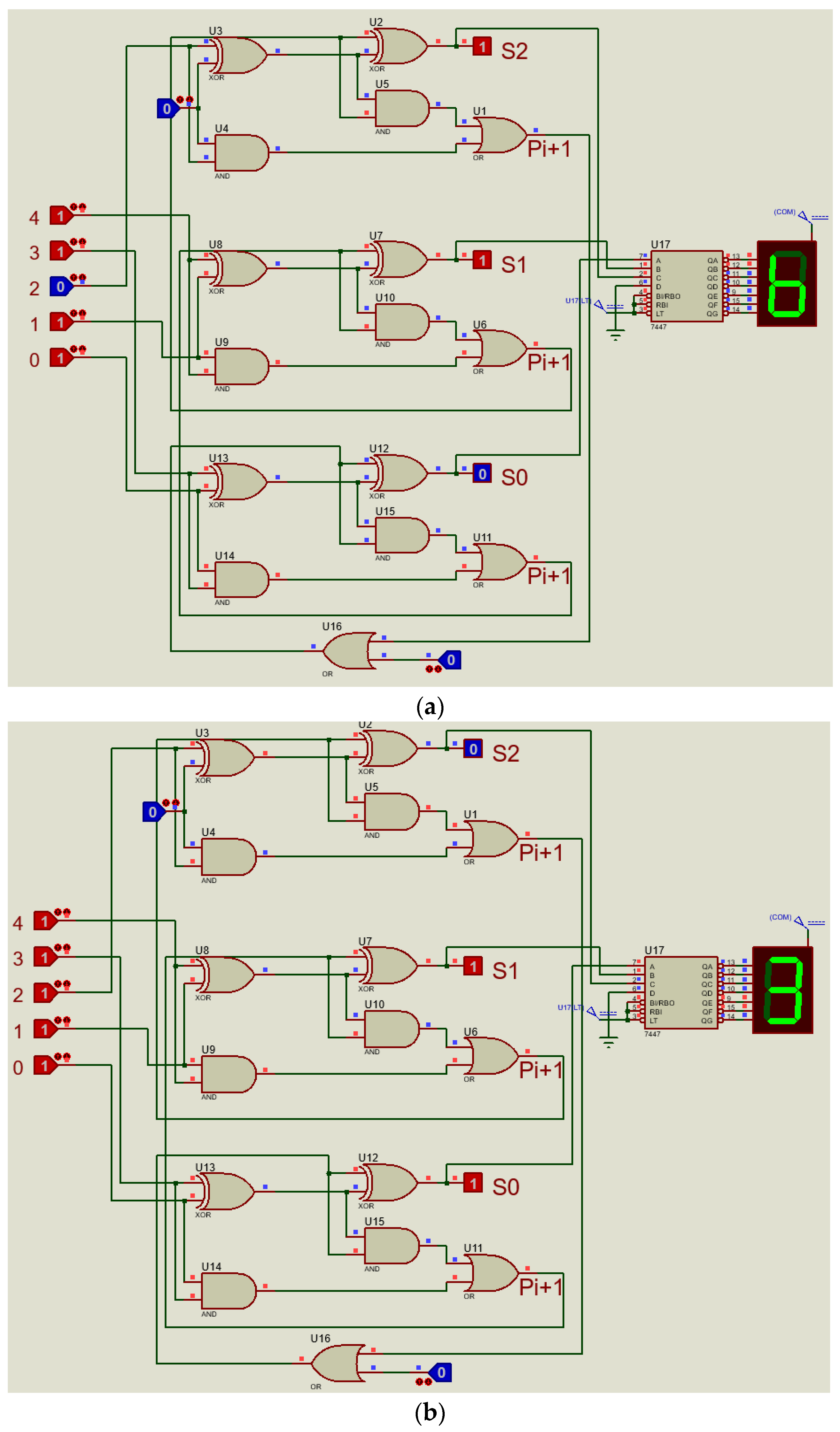


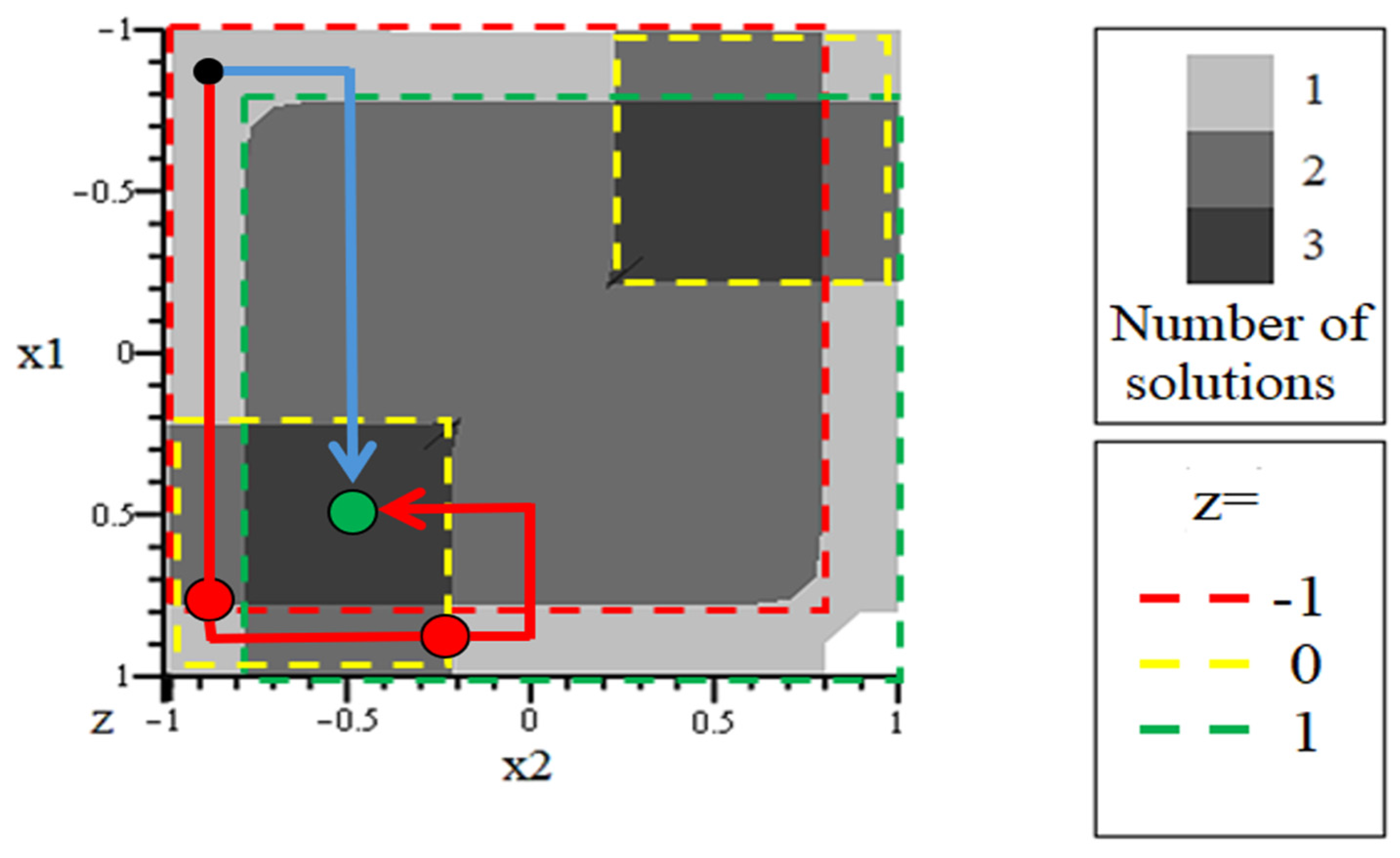
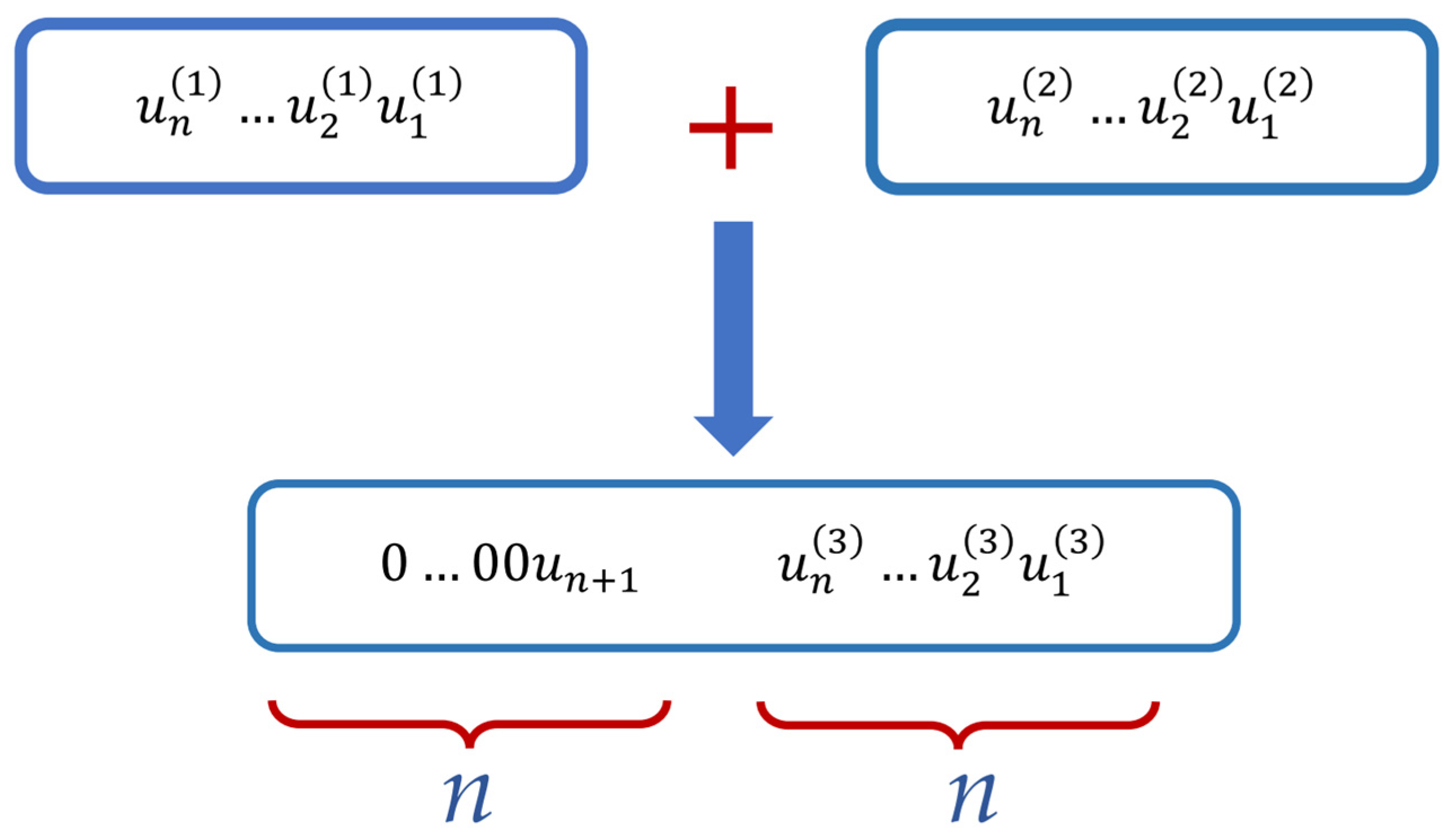

| P1 | p2 | p3 | p5 | p5 | lnP | G |
|---|---|---|---|---|---|---|
| 3 | 7 | 31 | 127 | 8191 | 29.34 | 29 |
| 3 | 7 | 31 | 127 | - | 16.34 | 16 |
| 3 | 7 | 31 | - | - | 9.35 | 9 |
| 3 | 7 | - | - | - | 4.39 | 4 |
| n | u1 | u2 | u3 | n1 | n1(2) | n1(2) u3 |
|---|---|---|---|---|---|---|
| 0 | 0 | 0 | 0 | 0 | 0 | 1 |
| 1 | 1 | 1 | 1 | 1 | 1 | 1 |
| 2 | 2 | 2 | 0 | 2 | 0 | 1 |
| 3 | 0 | 3 | 1 | 3 | 1 | 1 |
| 4 | 1 | 4 | 0 | 4 | 0 | 1 |
| 5 | 2 | 5 | 1 | 5 | 1 | 1 |
| 6 | 0 | 6 | 0 | 6 | 0 | 1 |
| 7 | 1 | 0 | 1 | 7 | 1 | 1 |
| 8 | 2 | 1 | 0 | 8 | 0 | 1 |
| 9 | 0 | 2 | 1 | 9 | 1 | 1 |
| 10 | 1 | 3 | 0 | 10 | 0 | 1 |
| 11 | 2 | 4 | 1 | 11 | 1 | 1 |
| 12 | 0 | 5 | 0 | 12 | 0 | 1 |
| 13 | 1 | 6 | 1 | 13 | 1 | 1 |
| 14 | 2 | 0 | 0 | 14 | 0 | 1 |
| 15 | 0 | 1 | 1 | 15 | 1 | 1 |
| 16 | 1 | 2 | 0 | 16 | 0 | 1 |
| 17 | 2 | 3 | 1 | 17 | 1 | 1 |
| 18 | 0 | 4 | 0 | 18 | 0 | 1 |
| 19 | 1 | 5 | 1 | 19 | 1 | 1 |
| 20 | 2 | 6 | 0 | 20 | 0 | 1 |
| 21 | 0 | 0 | 1 | 0 | 0 | 0 |
| 22 | 1 | 1 | 0 | 1 | 1 | 0 |
| 23 | 2 | 2 | 1 | 2 | 0 | 0 |
| 24 | 0 | 3 | 0 | 3 | 1 | 0 |
| 25 | 1 | 4 | 1 | 4 | 0 | 0 |
| 26 | 2 | 5 | 0 | 5 | 1 | 0 |
| 27 | 0 | 6 | 1 | 6 | 0 | 0 |
| 28 | 1 | 0 | 0 | 7 | 1 | 0 |
| 29 | 2 | 1 | 1 | 8 | 0 | 0 |
| 30 | 0 | 2 | 0 | 9 | 1 | 0 |
| 31 | 1 | 3 | 1 | 10 | 0 | 0 |
| 32 | 2 | 4 | 0 | 11 | 1 | 0 |
| 33 | 0 | 5 | 1 | 12 | 0 | 0 |
| 34 | 1 | 6 | 0 | 13 | 1 | 0 |
| 35 | 2 | 0 | 1 | 14 | 0 | 0 |
| 36 | 0 | 1 | 0 | 15 | 1 | 0 |
| 37 | 1 | 2 | 1 | 16 | 0 | 0 |
| 38 | 2 | 3 | 0 | 17 | 1 | 0 |
| 39 | 0 | 4 | 1 | 18 | 0 | 0 |
| 40 | 1 | 5 | 0 | 19 | 1 | 0 |
| 41 | 2 | 6 | 1 | 20 | 0 | 0 |
| Feature | Classic Binary Adder | Modular Adder on Mersenne Numbers | Trigger Adder on Neuromorphic Materials |
|---|---|---|---|
| Arithmetic type | Binary | Modular (on P) | Modular, supplemented by effects associated with hysteresis phenomena |
| Parallelism | Limited | High | High |
| Energy efficiency | Average | High | Potentially high |
| Implementation on polymers | No | No | Possible |
| Noise tolerance | Average | Medium | High (due to hysteresis) |
| Learning support | No | No | Yes (possible) |
Disclaimer/Publisher’s Note: The statements, opinions and data contained in all publications are solely those of the individual author(s) and contributor(s) and not of MDPI and/or the editor(s). MDPI and/or the editor(s) disclaim responsibility for any injury to people or property resulting from any ideas, methods, instructions or products referred to in the content. |
© 2025 by the authors. Licensee MDPI, Basel, Switzerland. This article is an open access article distributed under the terms and conditions of the Creative Commons Attribution (CC BY) license (https://creativecommons.org/licenses/by/4.0/).
Share and Cite
Shaltykova, D.; Kadyrzhan, K.; Caiko, J.; Vitulyova, Y.; Suleimenov, I. Trigger-Based Systems as a Promising Foundation for the Development of Computing Architectures Based on Neuromorphic Materials. Technologies 2025, 13, 326. https://doi.org/10.3390/technologies13080326
Shaltykova D, Kadyrzhan K, Caiko J, Vitulyova Y, Suleimenov I. Trigger-Based Systems as a Promising Foundation for the Development of Computing Architectures Based on Neuromorphic Materials. Technologies. 2025; 13(8):326. https://doi.org/10.3390/technologies13080326
Chicago/Turabian StyleShaltykova, Dina, Kaisarali Kadyrzhan, Jelena Caiko, Yelizaveta Vitulyova, and Ibragim Suleimenov. 2025. "Trigger-Based Systems as a Promising Foundation for the Development of Computing Architectures Based on Neuromorphic Materials" Technologies 13, no. 8: 326. https://doi.org/10.3390/technologies13080326
APA StyleShaltykova, D., Kadyrzhan, K., Caiko, J., Vitulyova, Y., & Suleimenov, I. (2025). Trigger-Based Systems as a Promising Foundation for the Development of Computing Architectures Based on Neuromorphic Materials. Technologies, 13(8), 326. https://doi.org/10.3390/technologies13080326






